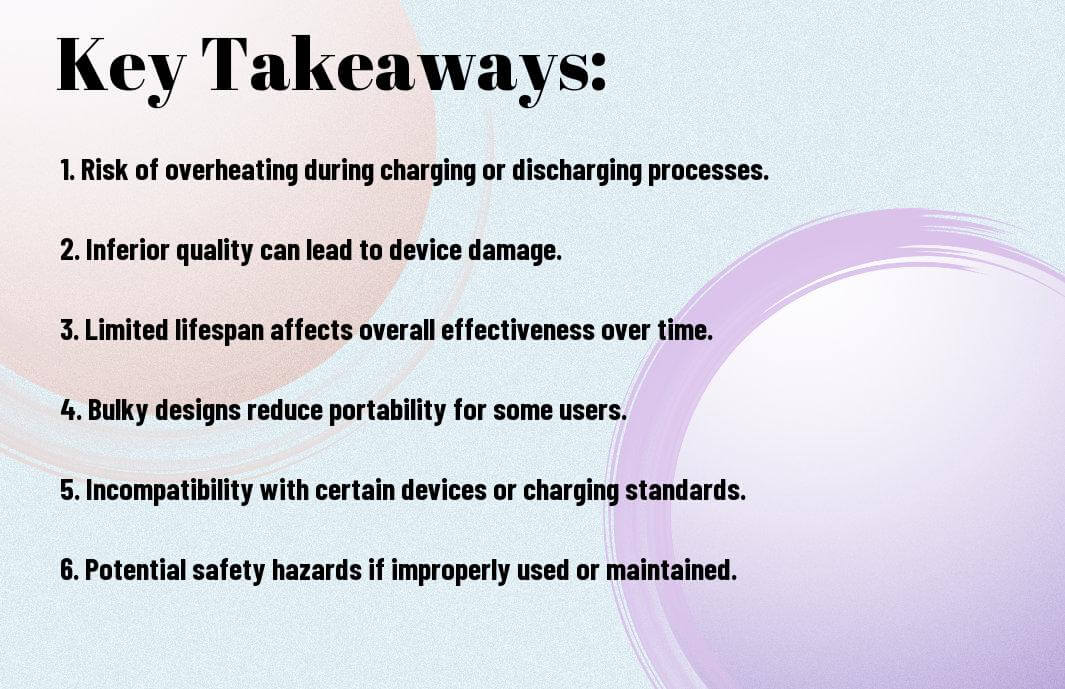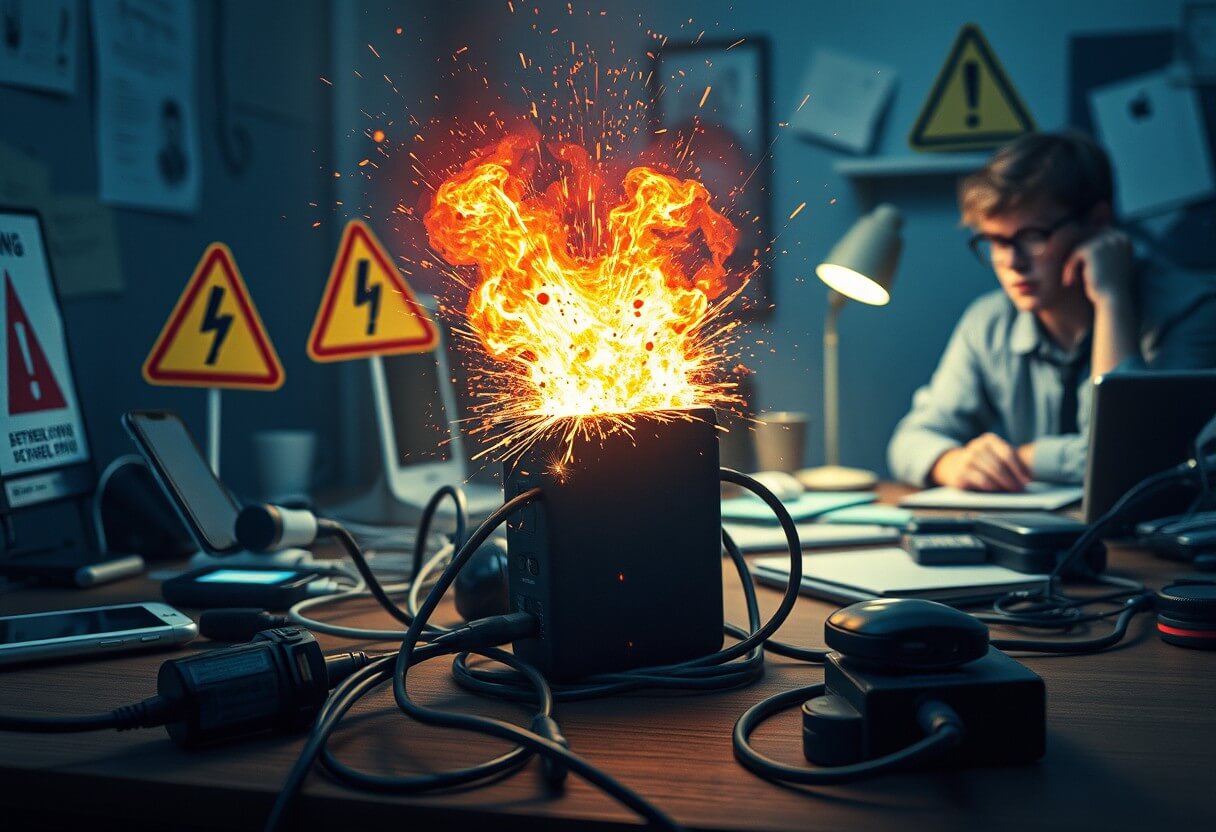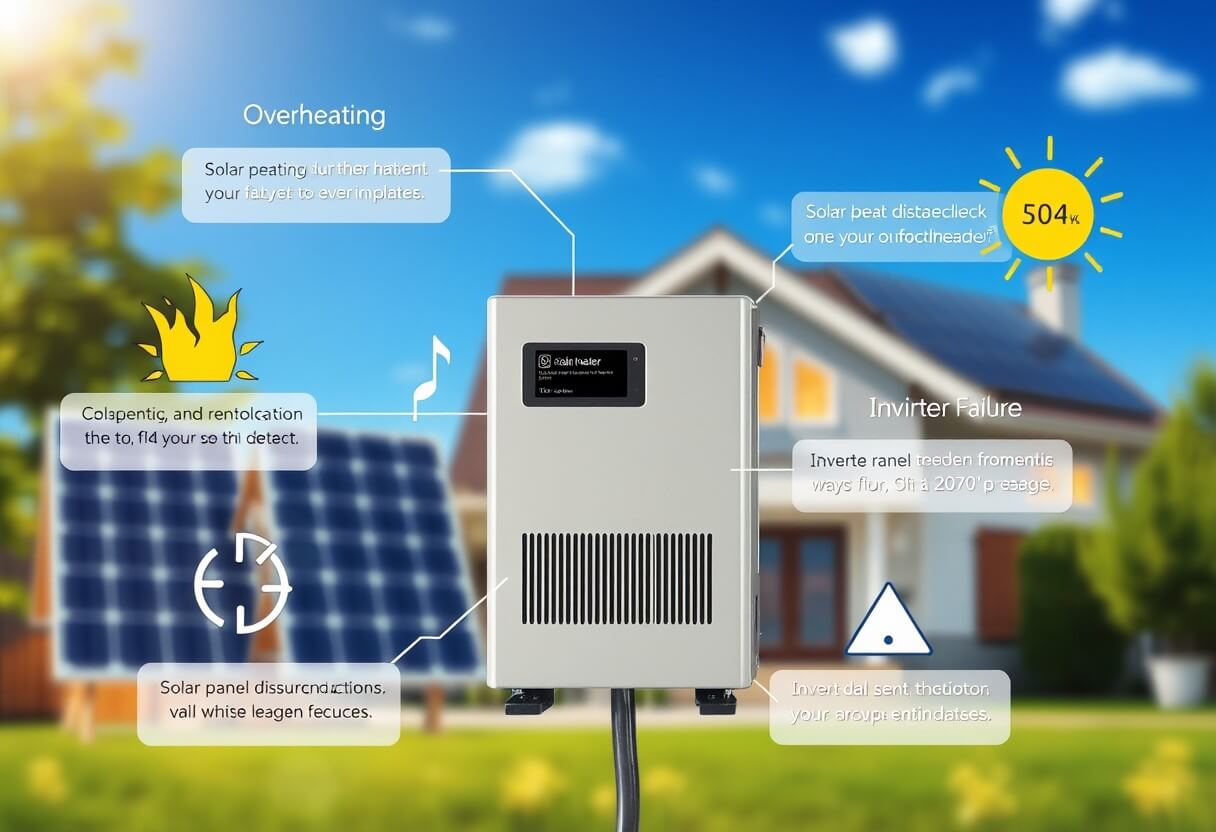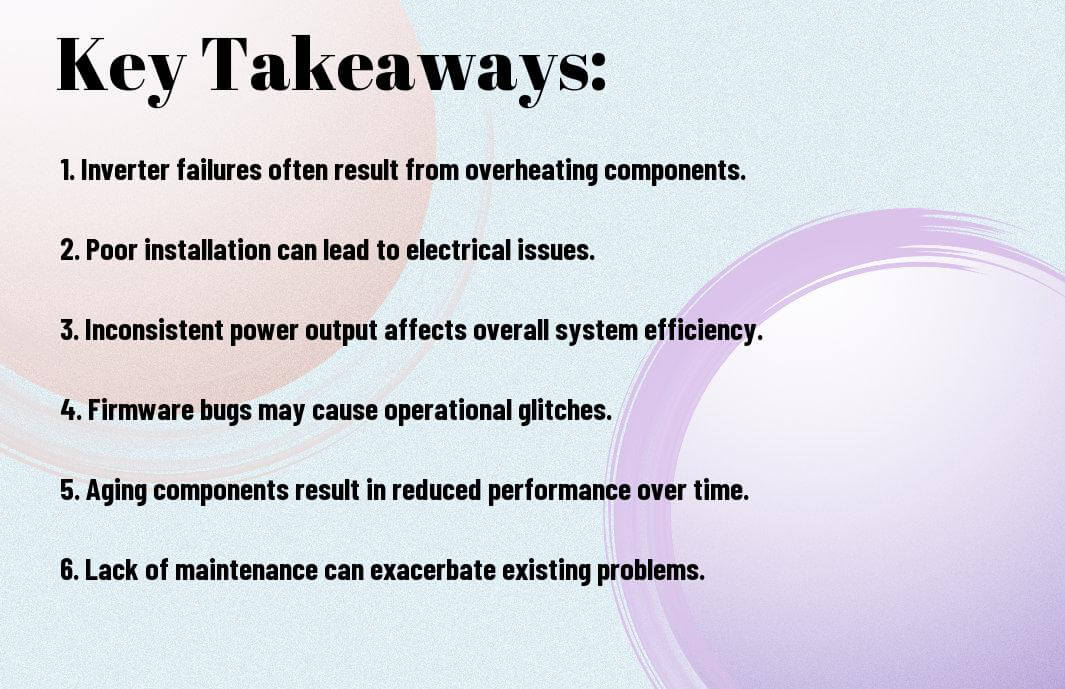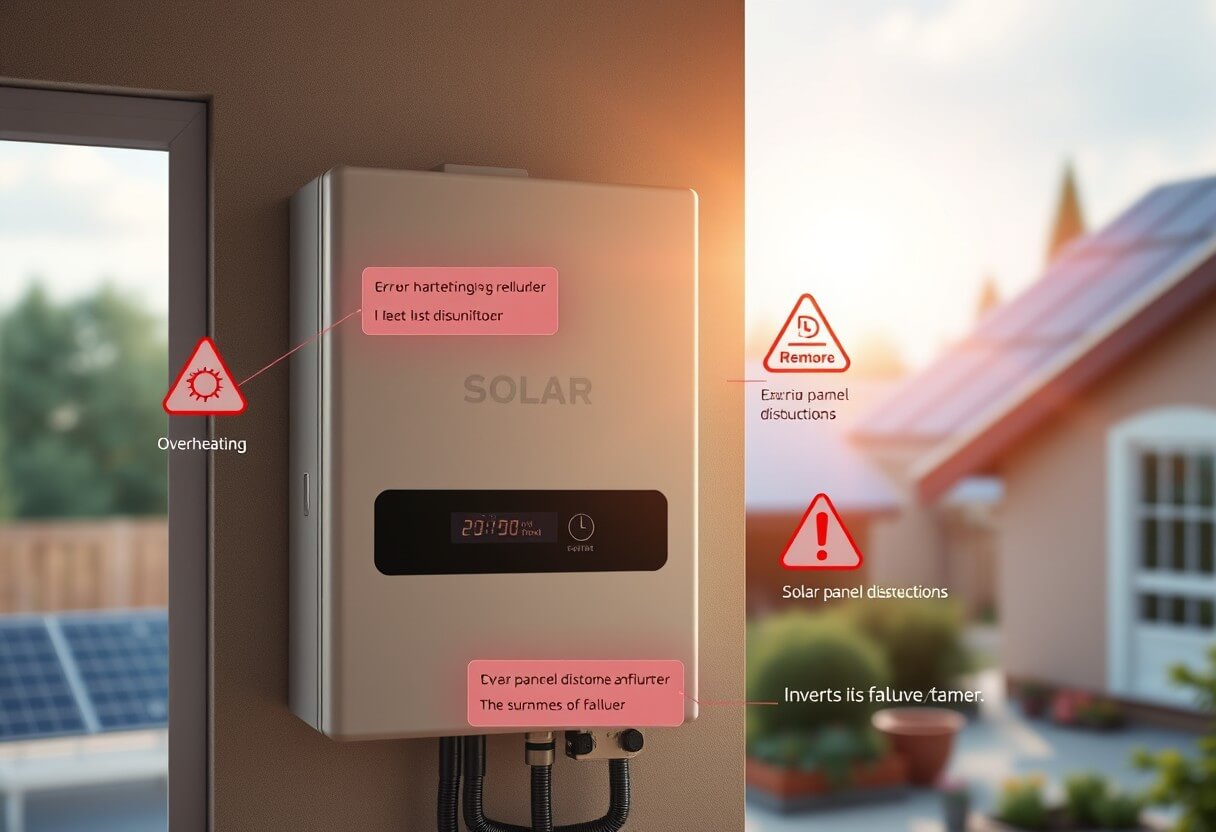Efficiency in portable charging can be a boon, but it’s important to consider the potential pitfalls that accompany power banks. While they offer convenience on-the-go, you may encounter risks such as battery safety issues, limited lifespan, and reduced charging speed. Furthermore, the quality of power banks varies widely, so you could find yourself investing in a subpar model that could damage your devices or fail when you need it most. Understanding these drawbacks will help you make informed decisions about your charging needs.
Key Takeaways:
- Battery Life: Overcharging or using low-quality power banks can lead to a shorter battery lifespan for your devices.
- Safety Risks: Poorly manufactured power banks can pose hazards such as overheating, bursting, or even causing fires.
- Compatibility Issues: Not all power banks are compatible with all devices, potentially leading to unreliable charging performance.
- Weight and Portability: Some power banks are bulky and heavy, which can reduce their convenience and portability.
- Cost: High-quality power banks may be expensive, and there are also cheaper options that may not deliver reliable performance.
Understanding Power Banks
Your mobile devices are necessary for staying connected, and power banks have become a popular solution for extended battery life. These portable chargers allow you to recharge your devices on-the-go, eliminating the anxiety of a dying battery while you are out and about. However, it’s necessary to understand the implications and limitations that come with using a power bank. For an in-depth exploration of safety guidelines, you can refer to the Power Bank Safety Guide | USB Makers.
Definition of Power Banks
One of the first things to understand about power banks is their fundamental purpose: they are external batteries that you can use to recharge your electronic devices without needing a wall outlet. Most power banks are rechargeable themselves and come equipped with one or more USB ports to connect your device. While they can be incredibly convenient, it’s important to choose high-quality products that comply with safety standards.
These portable chargers have varying capacities, typically measured in milliampere-hours (mAh), which indicate how much charge they can hold. The higher the mAh rating, the more times you can recharge your device before needing to recharge the power bank itself. However, not all power banks are created equal, and some may not provide the indicated capacity.
Types of Power Banks
Banks come in various forms and designs to cater to different needs and uses. Here are some common types you might encounter:
- Standard Power Banks: Basic portable chargers that come with a set capacity and one or more USB outputs.
- Solar Power Banks: Designed to be charged via sunlight, ideal for outdoor activities.
- Wireless Power Banks: Allow you to charge your devices without the need for a physical connection.
- Fast Charging Power Banks: Equipped with technology that allows for rapid charging of compatible devices.
- Multi-device Power Banks: Designed to charge multiple devices simultaneously.
Perceiving the variety of power bank types available can help you choose one that best meets your charging needs.
| Type | Features |
| Standard | Basic functionality, one or more USB outputs |
| Solar | Charged via solar energy; great for outdoor use |
| Wireless | Allows for charging without a cable connection |
| Fast Charging | Provides rapid charging for compatible devices |
| Multi-device | Can charge multiple devices at the same time |
This understanding of power banks will help you make informed decisions when selecting one that complements your lifestyle. Power banks can significantly enhance your device usage, but it’s crucial to consider their functionality, charging capacity, and added features. When combined thoughtfully with your daily routines, they can provide great convenience.
Common Uses of Power Banks
Definition of common uses involves recognizing that power banks serve various purposes beyond just charging smartphones. From travel to outdoor adventures, they extend the usability of portable electronics significantly. You can use power banks while on a camping trip to keep your camera or flashlight charged, during a long commute for your tablet, or even during business travels to ensure your laptop is always powered up.
This versatility makes power banks invaluable tools in modern life. They not only ensure that your devices remain functional, but also offer peace of mind knowing that you can rely on them during emergencies or extended outings. With careful consideration of their advantages and potential drawbacks, you can harness them effectively in your daily activities.
Potential Dangers of Power Banks
It is necessary to be aware of the potential dangers that power banks pose, as they have become increasingly popular accessories in our tech-centric lifestyles. While these devices offer convenient charging solutions, they also carry risks that can lead to dangerous situations. Understanding these hazards can help you make informed decisions while using and selecting a power bank for your electronic devices.
Battery Explosions
Dangers lurk when power banks are not manufactured with quality materials or when they are used improperly. One of the most alarming threats is the possibility of battery explosions. This could occur due to overcharging, short circuits, or using a power bank that has reached the end of its lifespan. If the internal battery is damaged or of low quality, it can swell, leak, or even explode, posing significant risks to your safety and property.
Overheating and Fires
An additional hazard associated with power banks is overheating, which can lead to fires. When a power bank is subjected to excessive charging or is left in a hot environment, it can overheat, causing the internal components to fail. These failures may ignite a fire, creating a severe risk not just to the device itself but also to your surroundings. It’s crucial to monitor your power bank’s temperature during use and avoid charging it overnight or in enclosed spaces.
Battery safety is paramount when using a power bank. Many incidents of overheating stem from extended use or misuse, reminding you always to choose quality products and adhere to the manufacturer’s guidelines. Furthermore, avoid charging multiple devices simultaneously if your power bank’s wattage is unable to support the cumulative load.
Short Circuits
On the topic of power bank safety, short circuits pose another significant threat. This electrical malfunction occurs when the positive and negative terminals come into contact, resulting in a sudden surge of electricity. Short circuits can cause the power bank to fail, potentially damaging the device you’re charging or even causing physical harm to you. Ensuring that your power bank is correctly maintained and avoiding damaged charging cables can mitigate the risk of short circuits.
Fires can often originate from short circuits, especially if flammable materials are nearby. Protect yourself by regularly inspecting your power bank for any signs of wear, ensuring that the casing remains intact and that no wires are exposed. If you notice any anomalies, it may be time to replace your power bank to ensure your safety.
Low-Quality Manufacturing
Shortcomings in manufacturing standards can lead to low-quality power banks that are significantly more prone to malfunction. Buying cheaper, poorly constructed power banks may save you money initially, but the long-term implications could be catastrophic. Devices that utilize substandard materials may not include vital safety features, increasing the likelihood of battery explosions, overheating, and other electrical hazards.
Power safety should always be your priority. Investing in a reputable brand with positive reviews can greatly reduce the risks associated with power banks. Look for devices that comply with safety certifications, as these are designed with necessary protective features that can help avoid dangerous incidents while ensuring your devices stay powered securely.
Health Risks Associated with Power Banks
Keep in mind that while power banks are a convenient way to keep your devices charged, they also come with potential health risks that you should be aware of. Many power banks emit a certain level of radiation, which raises concerns for users, especially if they use these devices frequently. It’s necessary to understand how this radiation can affect your long-term health.
Radiation Exposure
Risks associated with radiation exposure from power banks primarily come from their internal circuitry and batteries. These components can emit electromagnetic radiation, albeit generally at low levels. However, if you are using your power bank consistently while it’s plugged in, you may be exposed to higher levels of radiation than you might think. Long exposure may lead some individuals to develop symptoms like headaches or fatigue, although scientific data on chronic exposure is still limited.
It is advisable to keep your power bank at a distance while charging your devices and avoid using it when it’s extremely warm, as elevated temperatures can increase radiation emissions. Being informed and taking these precautions can help mitigate any potential health risks associated with radiation exposure.
Chemical Leakage
With the widespread use of power banks comes the potential risk of chemical leakage from the batteries they contain. Lithium-ion batteries, which are commonly found in power banks, must be managed carefully since they can puncture or overheat, leading to the release of toxic substances. Exposure to these chemicals can pose various health hazards, including skin irritation, respiratory issues, and more severe health concerns if ingested. It’s necessary to handle your power bank with care, ensuring that there are no visible signs of damage and that it’s not overheating during use.
Plus, disposing of power banks improperly can lead to environmental contamination, affecting not just your immediate health but also that of the broader ecosystem. Make sure to follow local regulations regarding the recycling or disposal of electronic devices to minimize these risks.
Electromagnetic Interference
Any electronic device that generates power can cause electromagnetic interference (EMI), and power banks are no exception. If you’re using your power bank while near sensitive medical devices, such as pacemakers or insulin pumps, you could potentially disrupt their functioning. This is particularly important for individuals who rely on these devices to manage their health effectively.
A good practice is to keep your power bank at least several inches away from such medical devices while they are in use. Taking this precaution helps ensure that you don’t inadvertently experience health complications stemming from EMI, allowing you to utilize your power bank safely.
Environmental Impact
Once again, while power banks provide an undeniable convenience in our increasingly mobile world, they also pose significant environmental challenges that you should consider. The production, use, and disposal of power banks contribute to various ecological issues, primarily due to the materials and processes involved in their lifecycle. It is crucial to remain aware of these impacts as you rely on such devices to keep your gadgets charged and ready for use.
Electronic Waste (E-Waste)
Any electronic device has the potential to become e-waste, and power banks are no exception. When your power bank reaches the end of its life, it may end up in a landfill, where it can take years to decompose. This leads to an increasing volume of electronic waste, which is known to contain hazardous materials such as lead, mercury, and cadmium. These substances can leach into the soil and groundwater, causing contamination and posing risks to both human health and the environment.
Besides the health risks associated with toxic materials, the sheer volume of discarded power banks strains waste management systems. Many people mistakenly place power banks in regular trash, creating challenges for recycling programs. As you continue to use these devices, it becomes imperative to understand your role in mitigating their environmental footprint by investing in responsible disposal methods.
Battery Disposal Challenges
Impact on the environment is intensified when it comes to the disposal of lithium-ion batteries commonly found in power banks. Most people are unaware that improper disposal can result in dangerous chemical leaks and fires, leading to severe consequences for landfills and the surrounding communities. To avoid these hazards, you must ensure that you dispose of your power bank in a manner that adheres to local regulations and promotes recycling.
With battery disposal challenges arising, many countries have started implementing stricter guidelines to tackle the e-waste crisis. You should familiarize yourself with these regulations and seek out designated collection points or recycling events in your area for electronic waste. Participating in these initiatives not only helps reduce the negative environmental impact of power banks but also contributes to fostering a culture of responsible consumption.
Resource Depletion
With the reliance on power banks growing, so does the demand for raw materials needed in battery production, such as lithium, cobalt, and nickel. The extraction of these resources often involves environmentally destructive mining practices that can lead to habitat destruction, soil degradation, and significant water usage. As you utilize power banks, it’s imperative to recognize the broader implications of this demand on our planet’s ecosystems.
Plus, the continuous need for new materials for battery production places pressure on miners and manufacturers to find efficient and cost-effective methods. This can sometimes lead to unethical mining practices that exploit workers and contribute to social injustices. By understanding the full lifecycle of your power bank, you can make more informed decisions about your usage and seek sustainable alternatives that mitigate these environmental concerns.
Safety Standards and Regulations
All power banks are not created equal, and understanding the safety standards and regulations surrounding them is crucial for your safety. The market is flooded with various options, but without proper oversight, the risks can outweigh the benefits. To learn about the pros and cons of using a power bank for charging your mobile phone, you can visit What are the pros and cons of using a power bank …. Proper standards ensure that manufacturers adhere to guidelines that prevent unsafe practices, ensuring the devices you purchase are reliable and safe.
International Safety Guidelines
With the increasing global dependence on portable charging solutions, various international safety guidelines have emerged to protect consumers. Organizations such as the International Electrotechnical Commission (IEC) and the Institute of Electrical and Electronics Engineers (IEEE) have laid down protocols that manufacturers must follow to ensure the performance and safety of lithium-ion batteries—commonly used in power banks. Adhering to these guidelines means devices are less likely to overheat, short-circuit, or even explode. You should always check if the power bank complies with these international standards before making a purchase.
With localized standards in place, countries also have tailored regulations to address their specific concerns. For example, in the U.S., the Underwriters Laboratories (UL) provides certification that power banks must meet to be considered safe for consumer use. Regulations may also involve specific testing that assesses the design and performance of the power banks, making it imperative for consumers like you to stay informed about these standards to avoid potential hazards.
Importance of Certification
Standards and regulations protect you, but certification is equally crucial. When a power bank is certified by recognized safety organizations, it serves as assurance that the device has undergone rigorous testing for performance and safety. Certified products are designed to minimize risks, making them the safer option for charging your devices. Non-certified power banks may save you a few bucks initially, but they could pose significant risks, including battery fires and electric shocks.
This aspect of certification ensures that the battery management systems are adequately designed to prevent overcharging, overheating, and other issues that can arise from poor manufacturing quality. Therefore, it is vital that you prioritize certified power banks to mitigate safety hazards and enjoy a peace of mind while using these devices.
Consumer Awareness
An crucial part of ensuring your safety when using power banks is staying informed about the products you choose. Many consumers overlook the importance of researching safety standards and certifications before making a purchase. Your awareness can significantly influence your buying decisions and ensure that you select a product that meets crucial safety benchmarks. By taking the time to investigate the brands and models available, you can avoid low-quality items that might endanger your electronics or, worse, pose safety risks to you.
For instance, reading user reviews and checking for safety certifications can bolster your trust in a product. Many consumers have reported issues with unregulated power banks, such as overheating and malfunctioning. Being aware of these user experiences can guide you away from potentially dangerous products. By being proactive and educating yourself about safety standards, you have the power to make informed decisions and protect your devices and yourself.
Best Practices for Safe Usage
Not all power banks are created equal, and without proper discernment, your experience can take a negative turn. It’s crucial to familiarize yourself with best practices for safe usage to maximize both safety and battery longevity. Following these guidelines will not only protect your devices but will also enhance your power bank’s performance, ensuring it serves you well for years to come.
Recommendations When Choosing a Power Bank
Any time you’re in the market for a power bank, it’s vital to consider the specifications carefully. Look for a reputable brand that follows industry standards and certifications such as UL or CE, which ensure that the product has been tested for safety. Pay attention to the power bank’s capacity, measured in milliampere-hours (mAh), and make sure it meets your needs. A power bank with a higher capacity may be more beneficial for those frequently charging multiple devices.
In addition, examine the output power ratings; a power bank with a higher amperage output can charge your devices quickly. If you use compatible cables and connectors, you can avoid potential hazards and inefficiencies that can occur with inferior charging methods. Your safety should always come first, and investing in a high-quality power bank can mitigate potential risks.
Proper Charging Techniques
To ensure the safety and efficiency of your power bank, adhere to proper charging techniques. Always use the manufacturer’s recommended charging cables and avoid using damaged or frayed cords. Additionally, do not leave your power bank plugged in for extended periods once it’s fully charged. Overcharging can lead to overheating, which poses risks to the device and your surroundings.
A helpful tip to keep in mind is to routinely check the battery health of your power bank. If you notice unusual behavior such as excessive heat or rapid battery drain, consider an immediate inspection. Such signs could indicate a defect and should be taken seriously to avoid any mishaps.
Storage and Handling Tips
With proper storage and handling, you can prolong the lifespan of your power bank. Avoid exposing your power bank to extreme heat or cold, as these conditions can impair its performance. When storing your power bank for an extended time, ensure it’s charged to about 50% and take it out occasionally to recharge. This can help maintain the battery’s health.
- Keep your power bank away from liquids and moisture to prevent damage.
- Store it in a cool, dry place, ideally within a protective case to prevent scratches or impact damage.
Assume that your power bank requires regular maintenance for optimal performance. Dust and debris can accumulate in the ports, so ensure to clean them periodically. This will prevent connectivity issues and enhance charging efficiency.
- Charge your power bank every few months to keep it in optimal condition during storage.
- Keep it safely out of reach of children and pets to avoid accidental damage or misuse.
Proper storage and handling extend beyond just finding a place to put your power bank. Consider its environment—temperature fluctuations, exposure to dirt, and even the pressure it experiences in your bag can influence its durability. Being thoughtful about how you treat your power bank can make a significant difference in its lifespan and overall functionality.
Summing up
With this in mind, it is vital for you to consider the potential downsides when relying on a power bank for your charging needs. One significant drawback is the limited battery life of the power bank itself, which may not provide enough charge to adequately power your devices during critical moments. Additionally, some low-quality power banks can overheat, posing a safety risk, or worse, they may not provide the required voltage or amperage leading to slower or ineffective charging. You also need to be aware of the additional bulk and weight a power bank adds to your daily carry, which may not be ideal for everyone.
Moreover, the long-term environmental impact of power banks should not be overlooked. As batteries degrade and eventually need to be disposed of, they can contribute to electronic waste unless properly recycled. Therefore, when considering purchasing a power bank, you should weigh these disadvantages along with the benefits it offers. You can further explore this subject by checking [What is the Advantages and disadvantages of power bank](https://www.linkedin.com/pulse/what-advantages-disadvantages-power-bank-mylionbattery) for a well-rounded understanding.
FAQ
Q: What are the safety risks associated with using power banks?
A: Power banks can pose safety risks such as overheating, short-circuiting, and even explosions if they are poorly manufactured. Low-quality power banks may not have adequate safety features, which can lead to battery swelling or failure. It’s imperative to choose reliable brands and regularly inspect the device for any signs of damage.
Q: Do power banks degrade over time, and how does this impact their performance?
A: Yes, power banks degrade over time due to the chemical processes within their batteries. Capacity can diminish due to factors like the number of charge cycles, extreme temperatures, and improper storage. This degradation results in decreased performance, making it difficult to fully charge devices or hold a charge for an extended period.
Q: Can using a power bank affect the lifespan of my device’s battery?
A: Frequent use of power banks to charge your devices can potentially impact battery lifespan. Rapid charging and inconsistent power supply may cause stress on the battery cells over time, leading to reduced battery health. It’s advisable to avoid using power banks as a primary charging method whenever possible and to charge your devices using their original chargers.
Q: Why do some power banks take a long time to charge devices?
A: The charging speed of a power bank depends on its capacity, output current rating, and the device being charged. Low-quality or lower-capacity power banks often have slower output currents, which can lead to longer charging times. Additionally, if the device’s charging requirements exceed what the power bank can deliver, the charging process will be prolonged.
Q: What environmental concerns are associated with power banks?
A: Power banks contribute to environmental issues because they contain lithium-ion batteries, which can be hazardous if not disposed of correctly. If not recycled properly, they can lead to soil and water contamination. Furthermore, the production and disposal of electronic waste can contribute to pollution. Consumers should manage their power bank usage responsibly and dispose of them at designated recycling centers.

